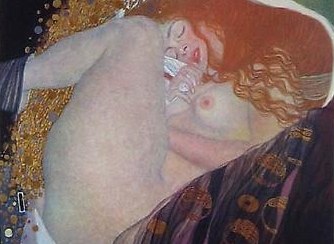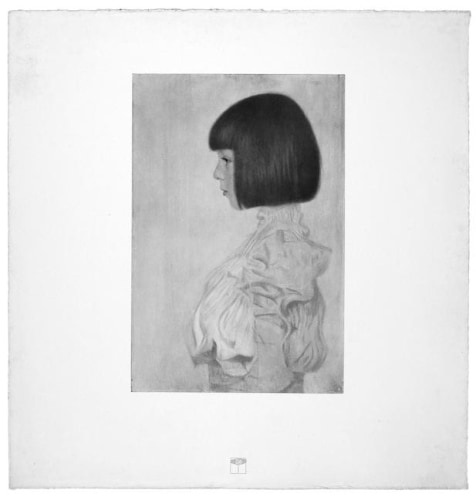
![DW001 Portrait of Helene Louise Klimt [ Das Werk]](https://img.artlogic.net/w_500,h_500,c_limit/exhibit-e/583dd7dc84184ed07e8b4568/8fe6a34ca1ad86fad33c8b99b7a2873d.jpg)


Inventory Number KLG270
Size 18.75h x 18w in
Material Collotype
Period Secessionist
Country of Origin Austria
Year Made 1914
Plate # 1/50.
Das Werk Gustav Klimts
1908-1914
Vienna, H. O. Miethke, Editor-Publisher
K.K. Hof- und Staatsdruckerei, Printer
50 prints in a limited edition of 300
Das Werk Gustav Klimts was issued in unbound in five gold-embossed black paper folders, each containing ten prints, two of which were multicolor. All prints are on heavy cream wove paper with deckled edges. Thirty-one, including the ten in multicolor, are collotypes printed on chine collé laid down on the wove paper support [see Appendix: Technical Processes]. Nineteen prints are high quality half-tones that exemplify the artistic capabilities of that process. The prints depict Klimt’s most important paintings dating from between 1898 and 1913. These fall into five thematic categories: 1. Allegorical; 2. Mythical or Biblical; 3. Portraits; 4. Erotic-Symbolist; and 5. Landscapes. Of the multicolor prints, two are allegorical (The Golden Knight, 1903; The Maiden, 1912-13), three mythical or biblical (Pallas Athena, 1898; Judith I, also known as Salome, 1901; Danae, 1907-08), one is a portrait (Emilie Flöge, 1902), three are erotic-Symbolist (Water Serpents I; Water Serpents II, both 1907-08; The Kiss, 1907-08), and one is a landscape (The Sunflower, c. 1906-07).
The monochrome collotypes and half-tones are printed in a variety of colored inks, ranging from deep brown to blue (Nuda Veritas) and green (Adele Bloch-Bauer II). The preponderance of landscapes – seventeen, all printed in halftone – suggests Klimt’s high estimation of these works. All the sheets and most of the images are in a square format, reflecting the formal importance of that geometric shape for Klimt (the square was also a key element in Wiener Werkstätte design). The remaining images are narrow rectangles, a format derived from Japanese paintings and woodblock pillar prints (Klimt was an avid admirer and collector of these artworks ).
A distinctive feature of Das Werk Gustav Klimts is the use of a unique signet for each print. Designed by Klimt, these signets are intaglio-printed in gold ink near the bottom of the sheet. Unlike the images, which are planar and rest upon the paper surface, the signets are impressed into the paper, indicating that images and signets were printed separately. Alice Strobl has documented the thematic relationship between the paintings and their signets, indicating the importance that Klimt placed on these devices. Detailed surviving sketches of the signets further corroborate this notion. The square shape of the signets mirrors that of the sheets and most of the images, reflecting Klimt’s acute concern for overall design.
In 1919 Hugo Heller reissued Das Werk Gustav Klimts as a boxed portfolio of loose prints in an edition of 230. The edition included printed essays by literary luminaries Hermann Bahr and Peter Altenberg, who praised Klimt as the consummate Viennese artist whose work would influence generations to come.
Yet even cursory examination shows that the prints in Heller’s edition are the same as those in the Galerie Miethke edition. Aside from the fact that the two editions exactly resemble each other in coloration (this only being possible if the same inks were used) and share the same signets, the short life of the collotype plate would have made it impossible for Heller to reprint the Miethke edition five years after its completion. The question then arises as to how many copies of Das Werk Gustav Klimts actually exist. If Heller came into possession of 230 copies of the portfolio, how to account for the 300 copies originally claimed by Galerie Miethke? Two explanations are likely. First, that the Miethke edition was actually larger than 300, counting documented presentation copies and the possible production of additional copies in anticipation of heavy demand. Second, sales of the Miethke edition may have been fewer than anticipated. This would account for the remainder of Heller’s edition. Since no documentation exists on this topic, the exact relationship between the Miethke and Heller editions remains a mystery. Although distributed in 1918, Heller’s edition of the portfolio obviously shares the Miethke edition’s impeccable standards of quality. Confidence in these standards, and in Klimt’s renewed standing as an artist, was firmly upheld when in 1908 Emperor Franz Joseph, the most powerful and influential man in Austria, became the first person to purchase Das Werk Gustav Klimts.